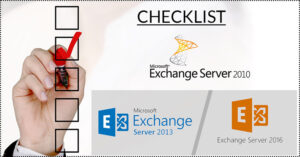Facing a tough time trying to recover Exchange and EDB files? We have got the perfect alternative which works like magic. Shoviv Exchange Recovery Manager is the ultimate tool to migrate Exchange to Office 365 and to safely recovery of Exchange files & repair EDB files and their storage. Thus, this tool Exchange mailboxes to Office 365 migration tool is a complete solution in itself.
All Your Needs Answered to Migrate Exchange to Office 365
Exchange Recovery Manager is an expert in migrating Office 365 to Exchange and Exchange to Office 365, as well as in the overall tasks related to Exchange recovery, file recovery, and import/export along with recovery of entire mailboxes. It can also work for selected files with corrupt EDB data and Live Exchange servers. It wins the user over with several other facilities that put together are bound to be a flawless Office 365 to Exchange migration.
Exchange Recovery Tool to Instant Migrate
In the age of technology, everyone has a busy lifestyle with no extra time to spare for time-taking tasks. By keeping the aspect in mind one can migrate Exchange to Office 365 not only accurately but also in a super-fast manner using Exchange Recovery Manager. It recovers intact as well as corrupt EDB files in the same time span. Thus, it makes the inaccessible EDB files accessible in no time. It restores all kinds of files- Emails, Calendars, Contacts, etc while also maintaining the folder hierarchy all the while.
Lets the user add Exchange mailboxes and Office 365 as a source
This feature proves to be useful in adding Office 365 mailboxes to other mailboxes, meaning that the user can benefit by exporting the added mailboxes to the target mailboxes. The target mailboxes may include Live Exchange, Office 365 as well. Additionally, this tool also converts EDB files to PST files.
The amazing feature of adding a public folder, to archive mailbox, and Outlook profile
The mailbox folder can archive by this recovery manager tool. In addition to that, the user also gets to add Live Exchange/ Office 365 public folder to other Live Exchange or Office 365 folder. The fact that this tool does all this while also taking care to manage folder hierarchy makes it a top player among recovery manager tools. Thus, Outlook stores migration into PST, Live Exchange, and Office 365 and is easy and quite accessible for everyone.
Preview option to preview source mailboxes items
The source mailbox items before they go to the migration task can be reviewed, meaning certain peace of mind for the users. Using this feature, any person can have the reassurance of the accuracy and integrity of the product. All the item properties are viewed with the MAPI tag.
Several options for the export format of the mailboxes
In addition to being a migration tool, the Exchange Recovery Manager also converts the added source mailboxes like Live Exchange, Office 365 mailboxes, and Outlook profile to any chosen target mailboxes. Using automatic and manual mapping the client can export the added mailboxes in Live Exchange and Office 365 with the safety of data. The mailbox data remains undamaged and all the files are kept safe during the whole process of migrating Exchange to Office365 with full certainty.
Easy conversion of EDB to PST
Regardless of the nature of the files, the intact or even corrupted EDB files can be extracted and converted into new and existing PST files. Corrupt EDB files are safely restored to new PST files by this tool without any risks or confusion.
Can split PST files into smaller ones
The software makes management of files easier by splitting them into any number according to the users’ convenience. Using this option, users can export source mailbox into single or multiple PST files, as per the user’s requirement. It is set by default to create a single PST file for each mailbox. In the case of the size of the PST file limitation by Outlook. This tool splits them once the provided size limit is reached.
Recovers data from corrupt EDB files
This tool which is created to migrate Exchange mailboxes to Office 365 files also works irrespective of all obstructions. Be it the huge size of the files or the recovery of corrupted/ non-corrupted EDB files, it does everything professionally. It also extracts single or multiple mailboxes from Office 365, Live Exchange, PST, EML, MSG, HTML, and RTF.
Auto-mapping service available
The user can migrate offline EDB, Live Exchange server to another offline EDB, and Live Exchange server. This is possible by the auto-mapping feature which maps the source mailbox to the target mailbox. the feature is available when the target mailbox is the same as the source mailbox.
Search and filter option for items
The client does not have to waste time searching for files anymore, it has been made instant by this migration tool. The user has to do nothing more than entering the criteria like to, from, cc, bcc, etc. And the desired file will produce immediately. They can also filter the message according to date and message class. This has made everything more convenient for all users and.
Different formats available for saving source mailbox items
This Exchange to Office 365 migration tool is also perfect for converting the source mailbox items into the format that the client chooses- Unicode, CAL, vCard, MSG, HTML, vCAL, etc. The option of importing source mailbox to various file formats using the bulk method is also available.
Can save the results in HTML format
This tool can do a lot more than just migration task. With this tool, one can save resultant reports into the HTML format. So the user exports and saves the files in the convenient HTML format using this tool.
We value your feedback and opinions; it helps us provide you with improvingly better services all the time. Feel free to contact us for feedback and help.
The tool also offers a free trial that you can test right now. To download the free demo of the tool, click here.
- How to Backup and Restore Emails in Webmail? - March 25, 2025
- How to Migrate Outlook to New Computer? - February 15, 2025
- Fix If Outlook Cannot Display the Specific Folder Location - February 1, 2025



